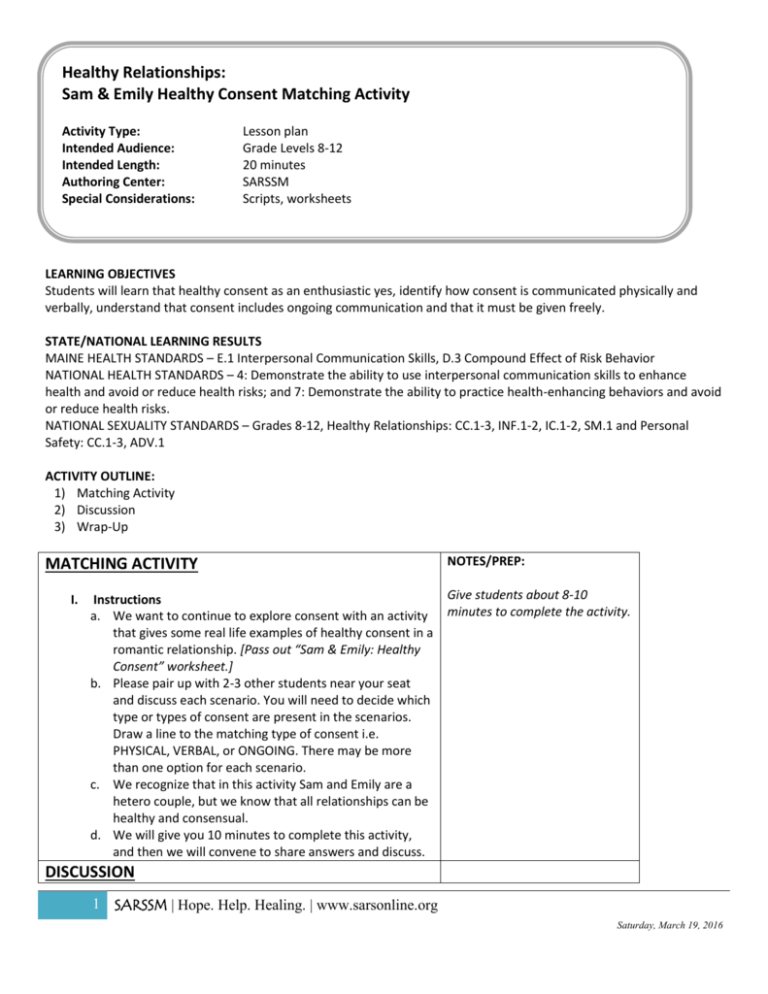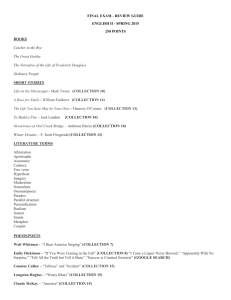
Sexual Assault Prevention
Healthy Relationships:
Sam
and
Healthy
Consent
Sam &
EmilyEmily:
Healthy Consent
Matching
Activity
Activity Type:
Intended Audience:
Intended Length:
Authoring Center:
Special Considerations:
Matching Activity
Lesson plan
Grade Levels 8-12
20 minutes
SARSSM
Scripts, worksheets
LEARNING OBJECTIVES
Students will learn that healthy consent as an enthusiastic yes, identify how consent is communicated physically and
verbally, understand that consent includes ongoing communication and that it must be given freely.
STATE/NATIONAL LEARNING RESULTS
MAINE HEALTH STANDARDS – E.1 Interpersonal Communication Skills, D.3 Compound Effect of Risk Behavior
NATIONAL HEALTH STANDARDS – 4: Demonstrate the ability to use interpersonal communication skills to enhance
health and avoid or reduce health risks; and 7: Demonstrate the ability to practice health-enhancing behaviors and avoid
or reduce health risks.
NATIONAL SEXUALITY STANDARDS – Grades 8-12, Healthy Relationships: CC.1-3, INF.1-2, IC.1-2, SM.1 and Personal
Safety: CC.1-3, ADV.1
ACTIVITY OUTLINE:
1) Matching Activity
2) Discussion
3) Wrap-Up
MATCHING ACTIVITY
I.
Instructions
a. We want to continue to explore consent with an activity
that gives some real life examples of healthy consent in a
romantic relationship. [Pass out “Sam & Emily: Healthy
Consent” worksheet.]
b. Please pair up with 2-3 other students near your seat
and discuss each scenario. You will need to decide which
type or types of consent are present in the scenarios.
Draw a line to the matching type of consent i.e.
PHYSICAL, VERBAL, or ONGOING. There may be more
than one option for each scenario.
c. We recognize that in this activity Sam and Emily are a
hetero couple, but we know that all relationships can be
healthy and consensual.
d. We will give you 10 minutes to complete this activity,
and then we will convene to share answers and discuss.
NOTES/PREP:
Give students about 8-10
minutes to complete the activity.
DISCUSSION
1 SARSSM | Hope. Help. Healing. | www.sarsonline.org
Saturday, March 19, 2016
I.
First Thoughts and Reactions
a. Was this activity difficult? Why?
b. Is this information new? Does our popular culture
show/model this kind of healthy communication?
(Movies, TV, and media show poor models of consent.)
c. Did you have any overlap on what matched up to which
kind of communication? Why do you think there was so
much overlap? (Consent in romantic situations is
normally a mix of body language and verbal cues, just
like in our everyday lives. We are experts at figuring out
if a person is feeling uncomfortable, weird, pressured or
annoyed by their body language. If it’s ever not clear,
we use verbal consent skills to see what’s going on in
their head before we initiate any activity, just like if you
asked to borrow your friend’s car/laptop/iphone and
they said yes, but you could tell they really didn’t feel
100% comfortable about it so you might double check
to see if they are really ok with it.)
II. Scenario 2 Discussion
a. Where did you match this scenario? Why?( Verbal
Consent and Ongoing Consent because they are verbally
agreeing not to share details of their private
relationship, and it is an ongoing agreement, even after
they break up.)
b. In a respectful relationship, who are Sam & Emily talking
to about their sexual activity? (Close friends only,
doctor, trusted adults, keeping it private, etc. They are
NOT telling their teammates, many friends, or bragging.)
c. Why would telling lots of people be disrespectful?
(Sharing private information, if an LGBT couple one
person might not be out. Rumors would spread about
them. )
III. Scenario 5 Discussion
a. Where did you match this scenario? (physical
communication/body language) Why? (They are both
participating with their bodies i.e. holding hands.)
b. What are some signs that they are comfortable with a
certain sexual activity? (Both participating and engaged,
open body language, smiling, squeezes hand back etc.)
c. What are some signs that one of them is uncomfortable
or uninterested in that sexual activity? (Stiffen up, don’t
participate, closed body language, pushing away hands,
2 SARSSM | Hope. Help. Healing. | www.sarsonline.org
Saturday, March 19, 2016
etc.)
IV. Scenario 6 Discussion
a. Where did you match this one up on the left, verbal,
physical or ongoing communication? (Likely verbal
communication, they are sharing experiences by talking
about them)
b. How do Sam and Emily talk about jealousy, their exes,
or past sexual partners and experience in a respectful
way? (They listen and talk openly/honestly and don’t
judge the other’s experience level. They can talk in
vague terms about their experience without using
names. Jealousy is an okay emotion to feel, but they
talk about the feeling, rather than causing a fight or
forbidding the person from ever talking to that person
again.)
V. Scenario 10 Discussion
a. Where did you match this one up on the left, verbal,
physical or ongoing communication? (verbal
communication, listening. Ongoing consent means
respecting boundaries and not asking again.)
a. What does respecting someone’s boundaries look like?
(Accepting the no, Talking about feelings and comfort
levels, Not pressuring them to change their answer.)
WRAP-UP
I.
Final Thoughts
a. Was this activity easy or difficult? Why?
b. It is clear that Sam and Emily work hard to
communicate with each other and practice respect
in their relationship. Consent is not just a legal
standard; it is also the foundation for a healthy
relationship.
c. We hope you have a clearer understanding of how
consent works in relationships.
3 SARSSM | Hope. Help. Healing. | www.sarsonline.org
Saturday, March 19, 2016
Sam & Emily: HEALTHY CONSENT
Sam and Emily are in high school and have been dating for a while. Having a healthy relationship is really important to
both of them. They work really hard at communication and try to talk about things as they come up.
DIRECTIONS: In small groups, discuss each scenario. Draw a line from each scenario on the left to match the different
stages of consent on the right. You may use more than one line for some scenarios.
SCENARIOS:
1.
Even though she was really nervous, Emily asked
Sam for a kiss when she wanted to kiss him.
2.
Sam and Emily decided together they wouldn’t
share the details of their sexual relationship with
their friends. They want to keep it private.
3.
Emily leans in to kiss Sam at the lunch table, but
stops when she sees he looks uncomfortable. She
waits until they’re alone later and asks if he’s
comfortable with PDA at school.
4.
When Emily and Sam are kissing, they both kiss
each other back.
5.
Sam wants to be romantic, so he tries to hold
Emily’s hand while they’re at a party with friends.
She smiles and squeezes his hand back.
6.
When Sam asks Emily about previous boyfriends,
she says she isn’t ready to talk about them. Sam
drops it, and doesn’t bug her about it.
7.
Emily takes off her shirt, and Sam helps.
8.
If Sam feels jealous of Emily’s ex who is a friend, he
will talk to her about it; explain how he is feeling,
and trust her. He won’t demand that Emily stops
talking to her friend or stop trusting her.
9.
Sam and Emily make eye contact with each other
and sometimes laugh while they’re making out.
Sometimes they get nervous and excited, but they
both feel safe and comfortable.
4 SARSSM | Hope. Help. Healing. | www.sarsonline.org
Saturday, March 19, 2016
10.
11.
Emily’s friends talk about texting sexual pics to
their boyfriends. Emily tells Sam she’s not into that.
It makes her feel weird and uncomfortable. Sam
listens and never asks her to do that.
Sam and Emily aren’t sure if they’re ready to have
sex or not, but they want to make the choice
together. They talk about it, and decide to use
protection when they decide they’re ready.
5 SARSSM | Hope. Help. Healing. | www.sarsonline.org
Saturday, March 19, 2016





